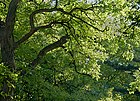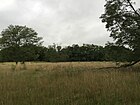Note: This is a project under development. The articles on this wiki are just being initiated and broadly incomplete. You can Help creating new pages.
Robinia pseudoacacia - Black locust
Robinia pseudoacacia commonly known in its native territory as black locust is a medium-sized deciduous tree native to the southeastern United States, but it has been widely planted and naturalized elsewhere in temperate North America, Europe, Southern Africa and Asia and is considered an invasive species in some areas. Another common name is false acacia, a literal translation of the specific name (pseudo meaning fake or false and acacia referring to the genus of plants with the same name.) It was introduced into Britain in 1636.
Contents
Uses
Tcombat tumors, gastritis, cough, sore throat, bronchitis, nervousness, asthma, mental fatigue, toothache, heal burns.
Parts Used
Chemical Composition
Pioglitazone (PubChem CID: 4829)Magnolol (PubChem CID: 72300)Honokiol (PubChem CID: 72303)Falcarindiol (PubChem CID: 5281148)Resveratrol (PubChem CID: 445154)Amorfrutin 1 (PubChem CID: 10132170)Rosiglitazone (PubChem CID: 77999)Quercetin (PubChem CID: 5280343)(−)-Catechin (PubChem CID: 73160)Linolenic acid (PubChem CID: 5280934)[1]
Common names
| Language | Common name |
|---|---|
| Kannada | |
| Hindi | |
| Malayalam | |
| Tamil | |
| Telugu | |
| Marathi | NA |
| Gujarathi | NA |
| Punjabi | NA |
| Kashmiri | NA |
| Sanskrit | |
| English |
Habit
Identification
Leaf
| Kind | Shape | Feature |
|---|---|---|
| Simple | Alternate, Pinnate | Leaves are pinnately compound with 7-21 small, round leaflets per leaf. Leaflets are 1.5 in. long. A pair of long, stipular spines is found at the base of most leaves |
Flower
| Type | Size | Color and composition | Stamen | More information |
|---|---|---|---|---|
| pea-shaped | 20.3 cm | white to yellow | 10 stemans | Flowering occurs in the spring, when showy, fragrant, white to yellow flowers develop in 8 in. long clusters |
Fruit
| Type | Size | Mass | Appearance | Seeds | More information |
|---|---|---|---|---|---|
| flattened pod | elongated | The flowers give way to a smooth, thin seed pod that is 2-4 in. (5.1-10.2 cm) in length | seeds many, ovoid | {{{6}}} |
Other features
List of Ayurvedic medicine in which the herb is used
- Vishatinduka Taila as root juice extract
Where to get the saplings
Mode of Propagation
How to plant/cultivate
Scarified seed may be drilled in rows 15–20 cm apart at 65–100 seeds per meter, or broadcast in fertile soil (Mar–May; US) and covered with ca I cm or less soil, sand, or sand and sawdust[3]
Commonly seen growing in areas
Mediterranian, Himalayas, Arabian countries.
Photo Gallery
References
External Links
- Pages that are stubs
- Ayurvedic Herbs known to be helpful to treat Tcombat tumors
- Ayurvedic Herbs known to be helpful to treat gastritis
- Ayurvedic Herbs known to be helpful to treat cough
- Ayurvedic Herbs known to be helpful to treat sore throat
- Ayurvedic Herbs known to be helpful to treat bronchitis
- Ayurvedic Herbs known to be helpful to treat nervousness
- Ayurvedic Herbs known to be helpful to treat asthma
- Ayurvedic Herbs known to be helpful to treat mental fatigue
- Ayurvedic Herbs known to be helpful to treat toothache
- Ayurvedic Herbs known to be helpful to treat heal burns
- Herbs with Roots used in medicine
- Herbs with seeds used in medicine
- Herbs with Flower used in medicine
- Herbs with bark used in medicine
- Habit - Deciduous Tree
- Index of Plants which can be propagated by Seeds
- Index of Plants which can be propagated by Cuttings
- Herbs that are commonly seen in the region of Mediterranian
- Herbs that are commonly seen in the region of Himalayas
- Herbs that are commonly seen in the region of Arabian countries
- Herbs








